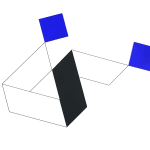Mehdi Moutashar French-Iraqi, b. 1943
Trois Plis à 60° et Deux Carrés (Three Folds at 60° and Two Squares), 2021
Painted wood, painted steel, elastic wire
141 x 191 cm
55 1/2 x 75 1/4 in
55 1/2 x 75 1/4 in
Moutashar’s art occupies a space between Western geometric abstraction and Islamic artistic traditions, fostering a dialogue between cultural heritage and contemporary expression. His work navigates a world of angles, folds,...
Moutashar’s art occupies a space between Western geometric abstraction and Islamic artistic traditions, fostering a dialogue between cultural heritage and contemporary expression.
His work navigates a world of angles, folds, and in-between spaces—a universe that lies between Iraq, his country of origin, and France, his adopted home. The titles of his works often reflect his creative process, with recurring terms like plis (folds), mouvement (movement), angles, and carrés (squares). While his pieces are not overtly calligraphic, they resonate with the language of Arabic calligraphy. His squares evoke the nuqta (dots) of the qalam (reed pen); black rectangles and lines fold into shapes reminiscent of calligraphic flourishes; and his methodical approach recalls the principles of the 10th-century Arab vizier and calligrapher Ibn Muqla.
In this body of work, Moutashar uses elastic materials to draw lines on the wall, dynamically bending and reconfiguring them into energetic geometric compositions, all while adhering to his self-imposed rules. These pieces emphasize the tension between voids and solid forms, light and shadow, inviting viewers to engage and interpret the fluid outlines in their own way.
His work navigates a world of angles, folds, and in-between spaces—a universe that lies between Iraq, his country of origin, and France, his adopted home. The titles of his works often reflect his creative process, with recurring terms like plis (folds), mouvement (movement), angles, and carrés (squares). While his pieces are not overtly calligraphic, they resonate with the language of Arabic calligraphy. His squares evoke the nuqta (dots) of the qalam (reed pen); black rectangles and lines fold into shapes reminiscent of calligraphic flourishes; and his methodical approach recalls the principles of the 10th-century Arab vizier and calligrapher Ibn Muqla.
In this body of work, Moutashar uses elastic materials to draw lines on the wall, dynamically bending and reconfiguring them into energetic geometric compositions, all while adhering to his self-imposed rules. These pieces emphasize the tension between voids and solid forms, light and shadow, inviting viewers to engage and interpret the fluid outlines in their own way.
1
of
10




